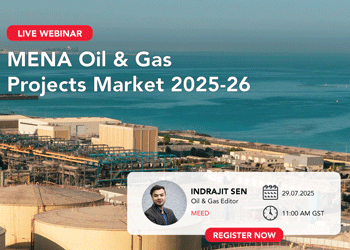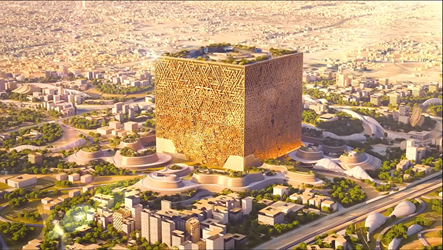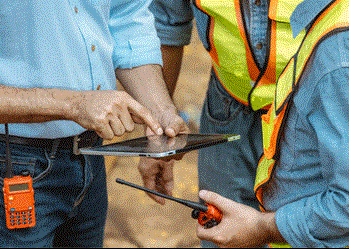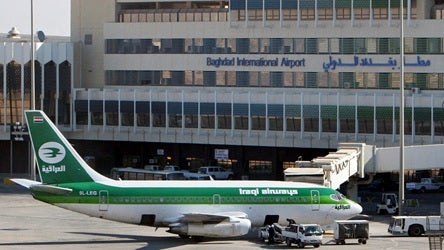Chinese firms dominate region’s projects market
5 March 2025

This package also includes: China construction at pivotal juncture
Chinese construction companies secured over $90bn in contracts in the Middle East and North Africa (Mena) in 2024. Their market share was 26% of the $347bn total for the region, according to regional projects tracker MEED Projects.
The record-breaking performance underscores the growing influence of Chinese firms in the region’s projects market.
In the past decade, Chinese construction companies have steadily increased their foothold in the region.
Between 2015 and 2019, the value of contracts won by Chinese firms ranged from $12bn to $23bn, reflecting a solid presence. There was a dip in 2016, when $12bn of awards reflected government spending cuts, and a second occurred in 2020, when lower oil prices and the impact of the Covid-19 pandemic led to awards of $13bn.
Since the pandemic, Chinese contractors’ orderbooks have grown sharply, with contract values rebounding to $26bn in 2021, dipping slightly in 2022 to $22bn. Then, in 2023, contracts awarded to Chinese contractors more than doubled to $51bn, rising even further to reach a record-breaking $90bn in 2024.
Leading players
According to MEED Projects, the top-ranking company by contract value and project volume based on work at the execution stage is China State Construction Engineering Corporation (CSCEC), with 47 projects totalling $23.5bn.
The other active companies are Sepco 3 Electric Power Construction Corporation, with $17.1bn of work across 14 projects; PowerChina, with $17bn across 22 projects; and Hualu Engineering & Technology, with $14bn of work concentrated in just three high-value projects.
Sinopec and China Energy Engineering Corporation managed 19 and 14 projects, respectively, reflecting their broad engagement in the region.
China Harbour Engineering Company has a more diversified orderbook, with 32 projects worth a total of $8.1bn. Meanwhile, China Petroleum Engineering & Construction Corporation has 27 projects, amounting to $5.7bn.
China’s strengths
The record volumes of work secured by Chinese contractors in recent years can be explained by a combination of factors.
Saudi Arabia has become the largest market for Chinese contractors in the Mena region
Traditionally, Chinese firms have enjoyed a lower cost base than their international competitors. This comes from lower manpower costs, access to cheaper materials and equipment, and financial support from state banks.
Culturally, Chinese firms have typically had a different attitude to risk than many other contractors. Instead of seeking to turn a profit on specific projects, Chinese firms have entered markets cautiously and, as their knowledge of the local market grew, built a commanding long-term position.
More recently, the edge that Chinese contractors enjoy has come from the technical experience they have gained from delivering large-scale, complex projects in their domestic market. While in the past Chinese contractors were only considered capable of delivering basic construction work, they now have some of the best project references in the world.
This was demonstrated in 2024, when CSCEC competed to complete the 1,000-metre-plus tower in Jeddah. The work was eventually given back to the incumbent Saudi Binladin Group, but when CSCEC was pursuing the contract, it boasted a portfolio of several completed super-high-rise and mega-tall projects, exceeding anything its competitors could demonstrate.
Meanwhile, in the UAE, the five groups that competed for the $5.5bn contract for Dubai Metro’s Blue Line extension all had at least one Chinese firm as a consortium member. The eventual winner was a team of Turkiye’s Limak Holding and Mapa Group with the Hong Kong office of China Railway Rolling Stock Corporation.
Oil and gas is another area where expertise has been developed. Twenty years ago, Chinese contractors could not prequalify for work on most oil and gas projects in the region, but today they compete for and win work from Mena’s leading oil companies. For example, Chinese firms won four of the 17 contracts awarded last year for the third expansion phase of Saudi Aramco’s Master Gas System project.
China’s domestic market has created a pool of resources that are being deployed internationally as the outlook for the Chinese construction market shows signs of weakness.
Chinese contractors have also been able to give their clients the solutions they require.
In North Africa, they have raised finances for projects in countries that in some cases lack funding. This has enabled Chinese companies to develop a steady pipeline of projects across North Africa.
In February this year, China’s Tianchen Engineering Corporation was selected by state-owned Egyptian Petrochemicals Holding Company to execute three contracts to develop industrial projects in Egypt. In Algeria, the Agence Nationale d’Etudes et de la Realisation des Investissements Ferroviaires (Anesrif) awarded a $476m railway line upgrade contract in late 2024 to a joint venture of China Railway Sixth Group and the local Infrarer.
In Saudi Arabia, where funding is less of a concern, Chinese contractors have been able to deploy the large project teams required to deliver Riyadh’s Vision 2030.
 Saudi foothold
Saudi foothold
Saudi Arabia has become the largest market for Chinese contractors in the Mena region, with $43bn of contract awards in 2024. This accounted for nearly 30% of the $143bn total for the kingdom last year.
Saudi Arabia’s Vision 2030 comes at a perfect time for Chinese contractors. Riyadh is hungry for resources to deliver its ever-growing roster of projects, including the five official gigaprojects, the requirements of which are extensive.
At the top level, they require funding and financial support, but contractors and suppliers are also needed to deliver the projects. The contract award numbers show that Chinese companies looking to expand their international reach have latched onto this opportunity.
For China, Saudi Arabia is not just a volume play. Other markets in Asia and Africa also offer opportunities for Chinese contractors as part of Beijing’s $4tn Belt & Road Initiative, launched in 2013. In recent years, however, the problem for Chinese companies in many of these markets is that the soft loans provided to complete projects cannot be repaid.
The key difference for China when looking at Saudi Arabia is that it sees a reliable market that is financially strong and backed by oil wealth.
Beyond construction, Chinese firms are investing in the Saudi supply chain, which is a pillar of Vision 2030. Earlier this year, China Harbour Engineering Company inaugurated a 200,000-square-metre modular building factory at gigaproject developer Roshn’s Sedra project in Riyadh.
Other investments include a steel plate manufacturing complex in Ras Al-Khair Industrial City, developed by Saudi Aramco, the Public Investment Fund (PIF) and China’s Baosteel; and Lenovo’s Oasis Project, a $2bn technology hub in Riyadh, set to manufacture computer devices and serve as the company’s regional headquarters for the Middle East and Africa.
The economic forces that bring Saudi Arabia and China together are also being encouraged, particularly by the PIF.
Last year, agreements worth up to $50bn were signed with major Chinese financial institutions, including the Agricultural Bank of China, Bank of China and China Construction Bank, to ensure a steady stream of funding for Chinese firms working in the kingdom.
Broader outlook
As the influence of Chinese contractors grows on the international stage, it has raised concerns. In 2022, the US Department of Defence released the names of what it calls “Chinese military companies”. The list included some of China’s largest contracting companies.
The economic forces that bring Saudi Arabia and China together are also being encouraged, particularly by the Public Investment Fund
In a statement at the time, the Department of Defence said it “is determined to highlight and counter the PRC [People’s Republic of China] Military-Civil Fusion strategy, which supports the modernisation goals of the People’s Liberation Army by ensuring its access to advanced technologies and expertise are acquired and developed by PRC companies, universities and research programmes that appear to be civilian entities”.
The sharp growth in contract awards secured by Chinese contractors in the Mena region since 2022 suggests this concern is limited outside the US.
Looking ahead, Chinese contractors are keen for more work in the Mena region. This was strongly signalled in mid-February, when CSCEC partnered with Cairo-based Al-Organi Group to secure contracts for the $24bn Ras El-Hekma project on Egypt’s Mediterranean coast.
The 170 million-square-metre master-planned development, backed by Abu Dhabi-based ADQ, is one of the world’s largest ongoing construction projects. The CSCEC-Al-Organi partnership has set a target to secure more than $5bn in contracts on the scheme within the next three years.
With major schemes in Egypt, Saudi Arabia and the rest of the Mena region, Chinese firms will be well positioned to deliver the region’s project ambitions.
Exclusive from Meed
-
 WEBINAR: Mena Oil & Gas Projects Market 2025-26
WEBINAR: Mena Oil & Gas Projects Market 2025-2610 July 2025
-

-
 Chinese firm wins Mid Island Parkway tunnelling deal
Chinese firm wins Mid Island Parkway tunnelling deal10 July 2025
-
 Iraq tenders Baghdad airport PPP project
Iraq tenders Baghdad airport PPP project9 July 2025
-

All of this is only 1% of what MEED.com has to offer
Subscribe now and unlock all the 153,671 articles on MEED.com
- All the latest news, data, and market intelligence across MENA at your fingerprints
- First-hand updates and inside information on projects, clients and competitors that matter to you
- 20 years' archive of information, data, and news for you to access at your convenience
- Strategize to succeed and minimise risks with timely analysis of current and future market trends

Related Articles
-
 WEBINAR: Mena Oil & Gas Projects Market 2025-26
WEBINAR: Mena Oil & Gas Projects Market 2025-2610 July 2025
Date & Time: Tuesday 29 July 2025 | 11:00 AM GST
Agenda:
1. Summary of the Mena oil, gas and petrochemicals projects market
2. Summary description of the main megaprojects, including project programmes
3. Analysis of active contracts and spending to date
4. Analysis of top contracts by work already awarded
5. Long-term capital expenditure outlays and forecasts
6. Highlights of key contracts to be tendered and awarded over the next 18 months
7. Top contractors and clients
8. Breakdown of spending by segment, ie, oil, gas, petrochemicals – upstream, downstream, onshore and offshore
9. Q&A session
https://image.digitalinsightresearch.in/uploads/NewsArticle/14241705/main.gif -
 New Murabba signs up South Korean firm for design works
New Murabba signs up South Korean firm for design works10 July 2025
Register for MEED’s 14-day trial access
Saudi Arabia’s New Murabba Development Company (NMDC) has signed a memorandum of understanding (MoU) with South Korea’s Heerim Architects & Planners to explore further design works on assets at the 14 square-kilometre New Murabba downtown project.
According to an official statement: “Heerim Architects & Planners will explore distinctive architectural plans that complement the development’s masterplan, with special focus on anchor assets, linear parks and smart city features.”
New Murabba CEO Michael Dyke signed the agreement last week during the company’s Investment and Partnership Forum in Seoul.
At the event, NMDC also signed an MoU with South Korea’s Naver Cloud Corporation to explore technological solutions for delivering the New Murabba downtown project.
According to an official statement: “The three-year agreement covers exploring innovative technology and automation to support the delivery of New Murabba, including robotics, autonomous vehicles, a smart city platform and digital solutions for monitoring construction progress.”
NMDC is in Seoul to examine technological offerings, assess financing options and showcase the investment opportunities available for the New Murabba downtown development.
The statement added that the excavation works for The Mukaab, the centrepiece of the overall development, have now been completed.
The Mukaab is a Najdi-inspired landmark that will be one of the largest buildings in the world. It will be 400 metres high, 400 metres wide and 400 metres long. Internally, it will have a tower on top of a spiral base and a structure featuring 2 million square metres (sq m) of floor space designated for hospitality. It will feature commercial spaces, cultural and tourist attractions, residential and hotel units, and recreational facilities.
Downtown destination
The New Murabba destination will have a total floor area of more than 25 million sq m and feature more than 104,000 residential units, 9,000 hotel rooms and over 980,000 sq m of retail space.
The scheme will include 1.4 million sq m of office space, 620,000 sq m of leisure facilities and 1.8 million sq m of space dedicated to community facilities.
The project will be developed around the concept of sustainability and will include green spaces and walking and cycling paths to promote active lifestyles and community activities.
The living, working and entertainment facilities will be developed within a 15-minute walking radius. The area will use an internal transport system and will be about a 20-minute drive from the airport.
The downtown area will feature a museum, a technology and design university, an immersive, multipurpose theatre, and more than 80 entertainment and cultural venues.
 READ THE JULY 2025 MEED BUSINESS REVIEW – click here to view PDF
READ THE JULY 2025 MEED BUSINESS REVIEW – click here to view PDFUAE and Turkiye expand business links; Renewed hope lies on the horizon for trouble-beset Levant region; Gulf real estate momentum continues even as concerns emerge
Distributed to senior decision-makers in the region and around the world, the July 2025 edition of MEED Business Review includes:
> AGENDA: UAE-Turkiye trade gains momentum> INTERVIEW 1: Building on UAE-Turkiye trade> INTERVIEW 2: Turkiye's Kalyon goes global> INTERVIEW 3: Strengthening UAE-Turkiye financial links> INTERVIEW 4: Turkish Airlines plans further growth> CURRENT AFFAIRS: Middle East tensions could reduce gas investments> GCC REAL ESTATE: Gulf real estate faces a more nuanced reality> PROJECTS MARKET: GCC projects market collapses> INTERVIEW 5: Hassan Allam eyes role in Saudi Arabia’s transformation> INTERVIEW 6: Aseer region seeks new investments for Saudi Arabia> LEADERSHIP: Nuclear power makes a global comeback> LEVANT MARKET FOCUS: Levant states wrestle regional pressures> GULF PROJECTS INDEX: Gulf projects index continues climb> CONTRACT AWARDS: Mena contract award activity remains subdued> ECONOMIC DATA: Data drives regional projects> OPINION: A farcical tragedy that no one can endTo see previous issues of MEED Business Review, please click herehttps://image.digitalinsightresearch.in/uploads/NewsArticle/14239016/main.jpg -
 Chinese firm wins Mid Island Parkway tunnelling deal
Chinese firm wins Mid Island Parkway tunnelling deal10 July 2025

Register for MEED’s 14-day trial access
Beijing-headquartered China Railway Tunnel Engineering Group has won a $60m subcontract for the tunnelling works on package 1B of the Mid Island Parkway project in Abu Dhabi.
Package 1B entails the construction of a cut-and-cover tunnel to cross the Khor Laffan Channel, which is the area between the Saadiyat and Um-Yifeenah islands.
The tunnel, which will be between 900 metres and 1 kilometre (km) long, is being constructed on a design-and-build basis and will tie in to packages 1A and 1C.
The project is being jointly constructed by a joint venture of local firm Yas Projects (Alpha Dhabi Holding) and Beijing-based China Railway International Group.
In June last year, MEED exclusively reported that Abu Dhabi's Department of Municipality & Transport had awarded contracts for three packages for phase one of the Mid Island Parkway Project (MIPP), as part of the Plan Capital urban evolution programme.
Phase one will start at the existing Saadiyat Interchange, which will connect the E12 road to the MIPP, and will end with the recently constructed Um-Yifeenah Highway.
It comprises a dual main road with a total length of 8km, including four traffic lanes in each direction, two interchanges, a tunnel and associated infrastructure works.
MIPP phase one is further divided into packages 1A, 1B and 1C, which were awarded separately.
The project ownership has been transferred from Aldar Properties to Abu Dhaibi's Department of Municipalities & Transport.
Previously, it was transferred from Abu Dhabi General Services Company (Musanada) to Aldar Properties, and the project was included in the Abu Dhabi Investment Office's public-private partnership project pipeline.
 READ THE JULY 2025 MEED BUSINESS REVIEW – click here to view PDF
READ THE JULY 2025 MEED BUSINESS REVIEW – click here to view PDFUAE and Turkiye expand business links; Renewed hope lies on the horizon for trouble-beset Levant region; Gulf real estate momentum continues even as concerns emerge
Distributed to senior decision-makers in the region and around the world, the July 2025 edition of MEED Business Review includes:
> AGENDA: UAE-Turkiye trade gains momentum> INTERVIEW 1: Building on UAE-Turkiye trade> INTERVIEW 2: Turkiye's Kalyon goes global> INTERVIEW 3: Strengthening UAE-Turkiye financial links> INTERVIEW 4: Turkish Airlines plans further growth> CURRENT AFFAIRS: Middle East tensions could reduce gas investments> GCC REAL ESTATE: Gulf real estate faces a more nuanced reality> PROJECTS MARKET: GCC projects market collapses> INTERVIEW 5: Hassan Allam eyes role in Saudi Arabia’s transformation> INTERVIEW 6: Aseer region seeks new investments for Saudi Arabia> LEADERSHIP: Nuclear power makes a global comeback> LEVANT MARKET FOCUS: Levant states wrestle regional pressures> GULF PROJECTS INDEX: Gulf projects index continues climb> CONTRACT AWARDS: Mena contract award activity remains subdued> ECONOMIC DATA: Data drives regional projects> OPINION: A farcical tragedy that no one can endTo see previous issues of MEED Business Review, please click herehttps://image.digitalinsightresearch.in/uploads/NewsArticle/14238039/main3047.gif -
 Iraq tenders Baghdad airport PPP project
Iraq tenders Baghdad airport PPP project9 July 2025
Register for MEED’s 14-day trial access
Iraq’s Ministry of Transport and the General Company for Airport & Air Navigation Services have released a tender inviting firms to bid for a contract to develop Baghdad International airport on a public-private partnership (PPP) basis.
The notice was issued in July, and the submission deadline is in September.
According to an official statement posted on its website, Iraq’s Ministry of Transport said that 10 out of 14 international consortiums that expressed interest in the project earlier this year have been prequalified to compete for the tender.
The scope of the estimated $400m-$600m project involves rehabilitating, expanding, financing, operating and maintaining the airport. It is the first airport PPP project to be launched in Iraq.
The initial capacity of the airport is expected to be around 9 million passengers, which will be gradually increased to 15 million passengers.
The International Finance Corporation (IFC), a member of the World Bank Group, is the project’s lead transaction adviser.
Iraq is already developing the Baghdad and Najaf-Karbala metro projects using a similar PPP model.
Earlier this month, MEED reported that Iraq intends to retender the contract to develop and operate the Baghdad Metro project, following the award of the estimated $2.5bn contract last year.
According to local media reports, Nasser Al-Assadi, adviser to Prime Minister Mohammed Sudani, stated that the previous developers had overestimated the project budget; therefore, the government will relaunch the entire process to implement the project.
https://image.digitalinsightresearch.in/uploads/NewsArticle/14229008/main.jpg -
 Contractors prepare revised bids for Roshn stadium
Contractors prepare revised bids for Roshn stadium9 July 2025

Register for MEED’s 14-day trial access
Saudi gigaproject developer Roshn has invited firms to submit revised commercial proposals by 24 July for a contract to build a new stadium adjacent to the National Guard facilities to the southwest of Riyadh.
Known as the National Guard Stadium, it will be delivered on an early contractor involvement (ECI) basis. It will cover an area of over 450,000 square metres and be able to accommodate 46,000 spectators.
The scope of work also covers the construction of auxiliary facilities, including training academy offices and two hotels, as well as retail and food and beverage outlets.
The firms had initially submitted bids on 8 April for the contract.
The stadium is scheduled to host 32 Fifa World Cup tournament games in 2034.
In August last year, MEED reported that Saudi Arabia plans to build 11 new stadiums as part of its bid to host the 2034 Fifa World Cup.
Eight stadiums will be located in Riyadh, four in Jeddah and one each in Al-Khobar, Abha and Neom.
The proposal outlines an additional 10 cities that will host training bases. These are Al-Baha, Jazan, Taif, Medina, Al-Ula, Umluj, Tabuk, Hail, Al-Ahsa and Buraidah.
The bid proposes 134 training sites across the kingdom, including 61 existing facilities and 73 new training venues.
The kingdom was officially selected to host the 2034 Fifa World Cup through an online convention of Fifa member associations at the Fifa congress on 11 December 2024.
 https://image.digitalinsightresearch.in/uploads/NewsArticle/14228507/main.jpg
https://image.digitalinsightresearch.in/uploads/NewsArticle/14228507/main.jpg

 China construction at pivotal juncture
China construction at pivotal juncture
